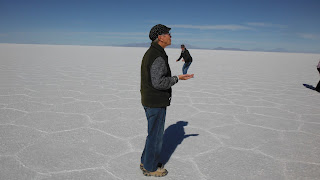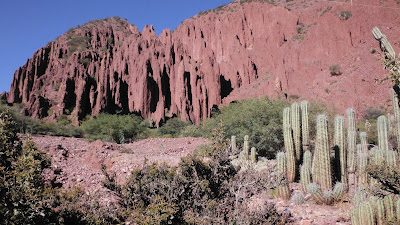 We left the comfortable confines of Tupiza, Bolivia - 4 of us in a 4x4Toyota from Tupeza Tours accompanied by a guide/translator/cook and a driver. We had to pay a little extra for an English speaking guide, which proved to be money well spent. Most of our luggage was tied on the roof under a plastic tarp, along with spare wheel, spare fuel and assorted other stuff.
We left the comfortable confines of Tupiza, Bolivia - 4 of us in a 4x4Toyota from Tupeza Tours accompanied by a guide/translator/cook and a driver. We had to pay a little extra for an English speaking guide, which proved to be money well spent. Most of our luggage was tied on the roof under a plastic tarp, along with spare wheel, spare fuel and assorted other stuff.After about 100 yards of pavement we were on dirt "roads" which would continue for the rest of the trip. They are actually very rough mountain roads which you would never consider tackling on your own. No signs, roads angling off all over to who knows where. Even with a GPS you would be lost in no time.
Day 1
Got to know our companions - the other two were a young couple from France, Guillaume and Emilie, driver Alfredo and Janet, the other valuable asset. Visited a few native villages, saw lots of Llama and Vicuna (related) and some great scenery, including snow-capped volcanoes. The jeep travelled well - we each had our own window. The dust was something to behold. Thank goodness the traffic was light.
Overnight at "new" San Antonio was very basic. Adobe building in a small village, no heat, electricity for lighting for 2 hours (7 to 9pm), 4 bed dorm with 4 blankets each plus the sleeping bags we rented. We sure needed them as the temperature dropped below freezing - we were at 13,800 ft altitude. Janet prepared a great supper and we were entertained by 5 local youngsters singing and playing their homemade flutes.
It was difficult to sleep due to the altitude and accompanying headaches.
Day 2
We were awaken at 5 am for our breakfast, packing in the dark and 6 am departure. The sun didn't rise until about 7.
First stop was "old" San Antonio - a large former Inca village of 2000 inhabitants. Apparently it was abandoned sometime during the conflicts with the Spanish. It was amazing how well preserved the buildings were - they were all made of stone and the roofs were the only parts that were missing. Contrast the construction of these houses with the ones in "new" San Antonio where we spent the previous night. There the homes were all adobe brick, which would be gone in no time if the village was abandoned.
An interesting creature inhabited the ruins of old San Antonio - a vizcacha - rabbit-like with a long curled tail and jumped like a kangaroo.
We visited several lagoons, some with pink flamingos. There are many mineral-laden lagoons with salty composition in this area, some of which are being mined. Entered the huge National Andean Fauna Reserve. We stopped at a hot springs for lunch and had a welcome hot soak in the cool air. You didn't need to towel off as in the dry, high altitude, you were dry in minutes.
Shortly before lunch we had a flat tire on the jeep. No problem. Alfredo had the spare off the roof, changed the tire and we were underway in 10 minutes max. Over lunch, he and some fellow drivers patched the tube (they use tube tires as they can be repaired anywhere) and put the tire back on the jeep.
We visited a beautiful lagoon with Volcan Zabaleri as a backdrop - the peak is a demarcation point between Chile, Argentina and Bolivia. At the end of the day we realized that we had met ZERO vehicles coming the other way during the entire day.
 |
| Almost 16,000 ft. Elevation |
 Accommodation (unplanned by the guide as we were running late and that was all that was available) was at 14,100 ft and was even more basic. Pit toilet (1) and no running water. Oh well we still had the 4 blankets and the sleeping bag. It was even colder than the night before. Still difficulty in sleeping and headaches due to the altitude.
Accommodation (unplanned by the guide as we were running late and that was all that was available) was at 14,100 ft and was even more basic. Pit toilet (1) and no running water. Oh well we still had the 4 blankets and the sleeping bag. It was even colder than the night before. Still difficulty in sleeping and headaches due to the altitude.Day 3
Were woken at 6am - real treat to sleep in! First stop was at Salta Manzana - a fantastic geothermal area. Lots of steam shooting from vents in the soil along with bubbling mud. Totally surreal. Took lots of photos but found sulphur deposits all over the camera and ourselves.
Next stop was the Red Lagoon - named for the colour of it's water - lots of pink flamingos. The red water is due to the mineral content. Then saw a volcano that is still smoking. Checked out of the national park - a great asset for Bolivia.
 The Siloli Desert was next - some weird rock formations. We climbed some of them and took too many photos. Then Laguna Honda with more flamingos - there is a hotel there so the birds are a little more used to humans - got quite close for photos. We are flamingoed out!Towards the end of the day we drove over the Chiyana salt flats at great speed towards our accommodation for the night in Jyaca.
The Siloli Desert was next - some weird rock formations. We climbed some of them and took too many photos. Then Laguna Honda with more flamingos - there is a hotel there so the birds are a little more used to humans - got quite close for photos. We are flamingoed out!Towards the end of the day we drove over the Chiyana salt flats at great speed towards our accommodation for the night in Jyaca.Interesting place to spend the night. All the walls and floors are made of salt from the huge Uyuni salt flats nearby. Also the tables and chairs. We had our own room - more like a closet but they had a !hot shower! - first in 3 days yaay! Still having trouble with the altitude.
Day 4
 |
| Sunrise over the salt flats |
5 am wakeup for 5.30 departure. Drove right onto the Uyuni salt flats - went about 20 km and stopped to watch the sunrise over the totally white salt. Awesome. The Uyuni salt flats are the largest in the world (about 12,000 sq km and also the highest at 12,000 ft. The surface is so uniform that it's elevation varies by less than 1 metre over the entire surface.It's so even that it is used to calibrate the altimeters of Earth-observation satellites. When it gets flooded in the rainy season, it becomes the worlds largest mirror!
 Next stop was an "island" - Incawaasi Is. in the salt flat. Apparently when it rains a lot (not too often in this desert environment) it does actually become an island . Otherwise you can drive right up to it. It was originally underwater and was covered with corals, which still cover most of the island's surface. It is densely populated with several varieties of cacti that are very similar to the saguaro cactus in Arizona. Hiked to the top - really noticed how laboured our breathing was in this altitude - 12,000 ft. Had a tailgate breakfast at the jeep.
Next stop was an "island" - Incawaasi Is. in the salt flat. Apparently when it rains a lot (not too often in this desert environment) it does actually become an island . Otherwise you can drive right up to it. It was originally underwater and was covered with corals, which still cover most of the island's surface. It is densely populated with several varieties of cacti that are very similar to the saguaro cactus in Arizona. Hiked to the top - really noticed how laboured our breathing was in this altitude - 12,000 ft. Had a tailgate breakfast at the jeep.The Uyuni salt flats have to be seen to be believed. They are immense. That day we drove about 140 km across them. The deepest is about 120m - all salt! Due to the whiteness and

uniformity of the surface, life becomes almost 2 dimensional. Distance perspective is lost. We had a blast in the middle of the flats taking weird photos of each other using the illusion of distance. Also got a sunburn - we were well covered due to the chilly weather but the sun plus reflection off the salt made for some red faces. Driving on the salt brings back memories of driving on frozen lakes in Canada.
Arrived in Uyuni about noon. Janet prepared our lunch while Alfredo drove us to the Train Graveyard. A huge area covered with ancient steam locomotives, coaches and all kinds of old railway equipment. Despite the graffiti it was an interesting spectacle. There must be a lack of ability to recycle the metal here - in Canada the scrap value would be huge.
Finally said goodbye to our team of Janet and Alfredo. They were excellent. Driving on those mountain roads requires constant focus on every rut and bend. Janet had to be up earlier and stay up later than us to prepare meals and wash up. She was awesome. Based on our experience, we would highly recommend Tupiza Tours.
 |
| Train Graveyard in Uyuni |












No comments:
Post a Comment